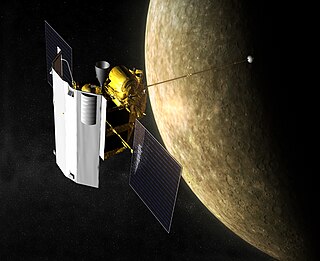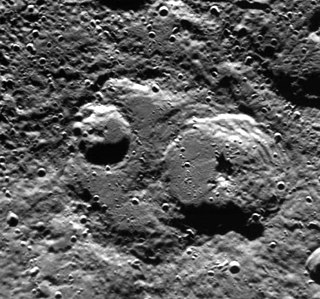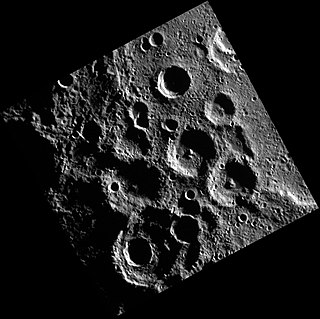
Mercury is the first planet from the Sun and the smallest in the Solar System. In English, it is named after the Roman god Mercurius (Mercury), god of commerce and communication, and the messenger of the gods. Mercury is classified as a terrestrial planet, with roughly the same surface gravity as Mars. The surface of Mercury is heavily cratered, as a result of countless impact events that have accumulated over billions of years. Its largest crater, Caloris Planitia, has a diameter of 1,550 km (960 mi) and one-third the diameter of the planet. Similarly to the Earth's Moon, Mercury's surface displays an expansive rupes system generated from thrust faults and bright ray systems formed by impact event remnants.

A lander is a spacecraft that descends towards, then comes to rest on the surface of an astronomical body other than Earth. In contrast to an impact probe, which makes a hard landing that damages or destroys the probe upon reaching the surface, a lander makes a soft landing after which the probe remains functional.

MESSENGER was a NASA robotic space probe that orbited the planet Mercury between 2011 and 2015, studying Mercury's chemical composition, geology, and magnetic field. The name is a backronym for "Mercury Surface, Space Environment, Geochemistry, and Ranging", and a reference to the messenger god Mercury from Roman mythology.

Shackleton is an impact crater that lies at the lunar south pole. The peaks along the crater's rim are exposed to almost continual sunlight, while the interior is perpetually in shadow. The low-temperature interior of this crater functions as a cold trap that may capture and freeze volatiles shed during comet impacts on the Moon. Measurements by the Lunar Prospector spacecraft showed higher than normal amounts of hydrogen within the crater, which may indicate the presence of water ice. The crater is named after Antarctic explorer Ernest Shackleton.

Cabeus is a lunar impact crater that is located about 100 km (62 mi) from the south pole of the Moon. At this location the crater is seen obliquely from Earth, and it is almost perpetually in deep shadow due to lack of sunlight. Hence, not much detail can be seen of this crater, even from orbit. Through a telescope, this crater appears near the southern limb of the Moon, to the west of the crater Malapert and to the south-southwest of Newton.

Chao Meng-Fu is a 167 km (104 mi) diameter crater on Mercury named after the Chinese painter and calligrapher Zhao Mengfu (1254–1322). Due to its location near Mercury's south pole and the planet's small axial tilt, an estimated 40% of the crater lies in permanent shadow. This combined with bright radar echoes from the location of the crater leads scientists to suspect that it may shelter large quantities of ice protected against sublimation into the near-vacuum by the constant −171 °C (−276 °F) temperatures.

The geology of Mercury is the scientific study of the surface, crust, and interior of the planet Mercury. It emphasizes the composition, structure, history, and physical processes that shape the planet. It is analogous to the field of terrestrial geology. In planetary science, the term geology is used in its broadest sense to mean the study of the solid parts of planets and moons. The term incorporates aspects of geophysics, geochemistry, mineralogy, geodesy, and cartography.

Aristoxenus is an impact crater near the north pole on Mercury. It was named by the IAU in 1979 after the Greek philosopher Aristoxenus.

Ictinus is a crater on Mercury. Its depth from crater floor to rim is 4.8 km. Its name was adopted by the International Astronomical Union in 1976. Ictinus is named for the Ancient Greek architect Ictinus, who lived in the 5th century BCE.

Li Chʻing-Chao is a crater on Mercury. It has a diameter of 61 kilometers. Its name was adopted by the International Astronomical Union (IAU) in 1976. Li Chʻing-Chao is named for the Chinese poet Li Qingzhao, who lived from 1081 to c. 1141.

A permanently shadowed crater is a depression on a body in the Solar System within which lies a point that is always in darkness.

Tolkien is one of the northernmost craters on Mercury, located in the Borealis quadrangle at 88.82 N, 211.08 W. It is 50 km in diameter. It was named after the South African born British writer J. R. R. Tolkien. The name was approved by IAU's Working Group for Planetary System Nomenclature on August 6, 2012. Since Tolkien is very close to the north pole, and Mercury has almost no axial tilt, Tolkien receives very little sunlight. S band radar data from the Arecibo Observatory collected between 1999 and 2005 indicates a radar-bright area covers the entire floor of Tolkien, which is probably indicative of a water ice deposit.

Magritte is a crater on Mercury, near the south pole. This crater was likely created by an impact event, as evident by its circular depression. Its name was adopted by the International Astronomical Union in 2012, after the Belgian painter, René Magritte. Magritte is one of several craters on Mercury named after famous artists. Per the Working Group for Planetary System Nomenclature, all Mercury craters are named after an artist who was famous for more than fifty years who has been deceased for more than three years at the time the crater is named.

Roerich is a crater on Mercury, near the south pole. Its name was adopted by the International Astronomical Union in 2013, after the Russian painter Nicholas Roerich.

Petőfi is a crater on Mercury, near the south pole. Its name was adopted by the International Astronomical Union in 2013, after the Hungarian poet Sándor Petőfi, following the official convention of naming craters on Mercury after historically significant artists, musicians, painters, and authors.

Scopas is a crater on Mercury, near the south pole. Its name was adopted by the International Astronomical Union in 1976, after the ancient Greek sculptor and architect Scopas, following the official convention of naming craters on Mercury after historically significant artists, musicians, painters, and authors.

Lovecraft is a crater on Mercury, located near the south pole. Its name was adopted by the International Astronomical Union (IAU) in 2013, after American author Howard Phillips Lovecraft.

Kobro is a crater near the south pole of the planet Mercury. Its name was adopted by the International Astronomical Union (IAU) on the December 12, 2012. Kobro is named for the Polish sculptor Katarzyna Kobro. It is adjacent to Komeda crater, which was named at the same time.

Komeda is a crater near the south pole of the planet Mercury. Its name was adopted by the International Astronomical Union (IAU) on the December 19, 2012. Komeda is named for the Polish composer Krzysztof Komeda. It is adjacent to Kobro crater, which was named at the same time.

Hurley is a crater on Mercury, located near the south pole. Its name was adopted by the International Astronomical Union (IAU) in 2013, after Australian photographer Frank Hurley.


















